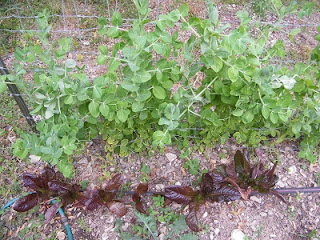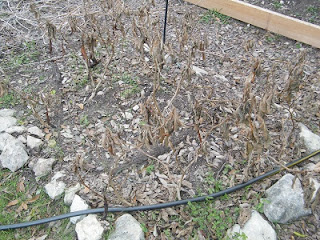This year was the first year I grew Tatume Squash, and they've already earned a permanent place in my garden! The most impressive thing about them is that even though they are a member of the
Cucurbita pepo species, the Squash Vine Borers didn't kill them! Oh, there was a little bit of damage to the vines, but overall the plants were still able to thrive and make a nice harvest.
This is exciting, because ever since I moved to San Marcos, the only squashes I've been able to grow are cushaws.
Here is a picture of the vines. Yes, they do have long vines, unlike most other summer squash cultivars. That does mean they take up more room in the garden, but it's also why the borers don't kill them. They have enough stems that if some get killed by borers, the plant has plenty of other ones.
Another interesting thing about this variety is the leaves. The leaves are much more deeply lobed than most other squash leaves. I wonder if that helps them be more heat and drought tolerant than other squashes, because they have that advantage also.
It makes sense since they're a Mexican variety. Unfortunately, It's a bit hard to find the seeds. The only place I've seen them for sale is Baker Creek Heirloom Seeds. I saved some of my own seeds this year to make sure I always have a supply.
The fruits themselves are like an egg-shaped zucchini. They're best harvested when they're not full size yet, though this one in the picture is a bit too small!
Even though I'm sure you could use them for any recipe you use any other summer squash in, I decided for my first taste of Tatume, I should try a recipe from their native land of Mexico: Calabacitas con Pollo, which means "squash with chicken."
There are several recipes for this dish out there, so I looked at a lot of them to see what the common denominators were. It's basically chicken braised in a tomato sauce flavored with Mexican spices, with cubed squash and sweet corn kernels mixed in.
After figuring that out, I didn't end up using a real recipe, so I'm just going to describe how I did it.
Calabacitas con Pollo
You will need:
- 4 pieces of bone-in, skin-on chicken (drumsticks, legs, or breasts)
- 2 Tatume squash
- 1 onion
- 2 or 3 hot peppers, depending on how spicy you want it (I used 2 red Serranos from the garden)
- vegetable oil for browning the chicken
- 2 or 3 cans of diced or crushed tomatoes, or plain tomato sauce, or some chopped up fresh tomatoes (I used tomatoes I had frozen from my tomato harvest that I thawed, peeled, and smashed up)
- about 2 tablespoons tomato paste (optional, but a good flavor booster)
- a couple of handfuls of frozen corn kernels
- cumin seeds - maybe about half a tablespoon
- salt to taste
- cilantro (optional, I didn't have any, but I bet it would be good)
First I browned the chicken in some oil in a Dutch oven on the stove. I used four drumsticks, but I think thighs would be even better. You could use breasts, but I think they dry out in braised dishes.
I set the chicken aside and added the chopped up onion to the oil and chicken fat left in the pan. Then I sprinkled whole cumin seeds over it. I didn't measure, so I'm just guessing it was about half a tablespoon. Cumin has a really nice savory flavor that really went well in the dish. You could use powdered cumin, but I would add that after you put the liquid in. I also added the finely diced hot peppers.
I cooked the onions on medium low heat until they were starting to turn golden. Then I put the chicken back in the pot, and dumped in enough crushed tomatoes and any juice that came out of them until the chicken was just barely covered. If you're using canned tomatoes, I guess it would take 2 cans, but maybe 3. If you don't have enough tomato to cover the chicken, I bet adding some chicken broth would work. You want the chicken to be just submerged in liquid. Then I added about a tablespoon or two of tomato paste, which gives it another level of flavor, and a sprinkle of salt.
Then I put the lid on and let the chicken simmer. This could probably also be done in an oven or slow cooker, but you'd have to figure out how long that would take yourself.
While the chicken was simmering, I diced up the squash. I didn't want my squash to turn completely to mush, so I let the chicken cook a bit first before I added it. After the chicken had cooked for about half an hour, I added the squash, and let that cook until the squash was tender, which took about 20 minutes.
Then I added two or three handfuls of frozen sweet corn straight out of the bag. The sweet corn only needed a few minutes to cook. Once all the vegetables were cooked, the chicken was starting to fall off the bone. Yum!
I served it over white rice (brown rice would work too) with warm flour tortillas on the side (corn would work too). I like things spicier than my husband, so I went easy with the hot peppers in the actual dish, but added Mexican-style hot sauce to my own portion.
A sprinkle of fresh cilantro on top would be nice, but we didn't have any.
If the people you're serving this to are offended by bones in their food, you can pull the chicken pieces out, pull the meat off them, add the meat back to the pot, and discard the bones before serving it. Except I highly recommend that you use
bone-in chicken for this. The bones (and skin!) add a lot of flavor to the broth as the chicken cooks. If you absolutely must use boneless chicken, be sure to reduce the cooking time, because meat with bones in it always takes longer to cook than boneless.
If you don't have Tatume squash, the flavor of it is most similar to a really good zucchini. It has a nice nuttiness to it, and the flesh is firm so it stands up to this kind of cooking method without getting mushy too fast. Yellow squash would probably be good in this too, but it has a much different, sweeter flavor.
Now that I've finally found a
C. pepo variety that can survive in my garden despite the borers, I'm already wondering if I can do some breeding experiments with it. Maybe I could transfer it's borer-resistance to other squash varieties. I've never actually tried something like that before, but that's what I get for reading
Breed Your Own Vegetable Varieties. I wonder what a cross between Tatume and a yellow crookneck would be like, or maybe a patty-pan..
Oh well, Tatume is a very good squash variety in its own right. I'll probably be growing it year after year, since all other summer squash I grow get completely eaten up by borers.
This is a great example of the advantage of heirloom varieties. If you have trouble growing the standard varieties of a crop, maybe you just need to track down a local heirloom that's adapted to your area. This is also why it's so important to preserve heirlooms, because you want to make sure that local heirloom still exists.




















































